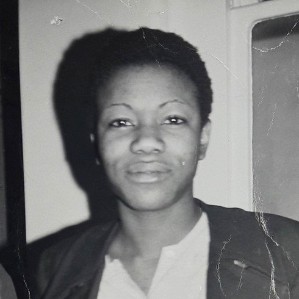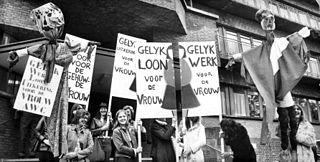
Lesbian feminism is a cultural movement and critical perspective that encourages women to focus their efforts, attentions, relationships, and activities towards their fellow women rather than men, and often advocates lesbianism as the logical result of feminism. Lesbian feminism was most influential in the 1970s and early 1980s, primarily in North America and Western Europe, but began in the late 1960s and arose out of dissatisfaction with the New Left, the Campaign for Homosexual Equality, sexism within the gay liberation movement, and homophobia within popular women's movements at the time. Many of the supporters of Lesbianism were actually women involved in gay liberation who were tired of the sexism and centering of gay men within the community and lesbian women in the mainstream women's movement who were tired of the homophobia involved in it.

Monica Sjöö was a Swedish-born British-based painter, writer and radical anarcho/ eco-feminist who was an early exponent of the Goddess movement. Her books and paintings were foundational to the development of feminist art in Britain, beginning at the time of the founding of the women's liberation movement around 1970.
The New American Movement (NAM) was an American New Left multi-tendency socialist and feminist political organization established in 1971.
Virago is a British publisher of women's writing and books on feminist topics. Started and run by women in the 1970s and bolstered by the success of the Women's Liberation Movement (WLM), Virago has been credited as one of several British feminist presses that helped address inequitable gender dynamics in publishing. Unlike alternative, anti-capitalist publishing projects and zines coming out of feminist collectives and socialist circles, Virago branded itself as a commercial alternative to the male-dominated publishing industry and sought to compete with mainstream international presses.

Spare Rib was a second-wave feminist magazine, founded in 1972 in the United Kingdom, that emerged from the counter culture of the late 1960s as a consequence of meetings involving, among others, Rosie Boycott and Marsha Rowe. Spare Rib is now recognised as an iconic magazine, which shaped debate about feminism in the UK, and as such it was digitised by the British Library in 2015. The magazine contained new writing and creative contributions that challenged stereotypes and supported collective solutions. It was published between 1972 and 1993. The title derives from the Biblical reference to Eve, the first woman, created from Adam's rib.

Feminist art is a category of art associated with the feminist movement of the late 1960s and 1970s. Feminist art highlights the societal and political differences women experience in their lives. The goal of this art form is to bring a positive and understanding change to the world, leading to equality or liberation. Media used range from traditional art forms, such as painting, to more unorthodox methods such as performance art, conceptual art, body art, craftivism, video, film, and fiber art. Feminist art has served as an innovative driving force toward expanding the definition of art by incorporating new media and a new perspective.
Feminism in France is the history of feminist thought and movements in France. Feminism in France can be roughly divided into three waves: First-wave feminism from the French Revolution through the Third Republic which was concerned chiefly with suffrage and civic rights for women. Significant contributions came from revolutionary movements of the French Revolution of 1848 and Paris Commune, culminating in 1944 when women gained the right to vote.

Griselda Frances Sinclair Pollock is an art historian and cultural analyst of international, postcolonial feminist studies in visual arts and visual culture. Since 1977, Pollock has been an influential scholar of modern art, avant-garde art, postmodern art, and contemporary art. She is a major influence in feminist theory, feminist art history, and gender studies. She is renowned for her innovative feminist approaches to art history which aim to deconstruct the lack of appreciation and importance of women in art as other than objects for the male gaze.

Olive Elaine Morris was a Jamaican-born British-based community leader and activist in the feminist, black nationalist, and squatters' rights campaigns of the 1970s. At the age of 17, she claimed she was assaulted by Metropolitan Police officers following an incident involving a Nigerian diplomat in Brixton, South London. She joined the British Black Panthers, becoming a Marxist–Leninist communist and a radical feminist. She squatted buildings on Railton Road in Brixton; one hosted Sabarr Books and later became the 121 Centre, another was used as offices by the Race Today collective. Morris became a key organiser in the Black Women's Movement in the United Kingdom, co-founding the Brixton Black Women's Group and the Organisation of Women of African and Asian Descent in London.

Rozsika Parker was a British psychotherapist, art historian and writer and a feminist.

Martha Shelley is an American activist, writer, and poet best known for her involvement in lesbian feminist activism.
The feminist art movement refers to the efforts and accomplishments of feminists internationally to produce art that reflects women's lives and experiences, as well as to change the foundation for the production and perception of contemporary art. It also seeks to bring more visibility to women within art history and art practice. The movement challenges the traditional hierarchy of arts over crafts, which views hard sculpture and painting as superior to the narrowly perceived 'women's work' of arts and crafts such as weaving, sewing, quilting and ceramics. Women artists have overturned the traditional view by, for example, using unconventional materials in soft sculptures, new techniques such as stuffing, hanging and draping, and for new purposes such as telling stories of their own life experiences. The objectives of the feminist art movement are thus to deconstruct the traditional hierarchies, represent women more fairly and to give more meaning to art. It helps construct a role for those who wish to challenge the mainstream narrative of the art world. Corresponding with general developments within feminism, and often including such self-organizing tactics as the consciousness-raising group, the movement began in the 1960s and flourished throughout the 1970s as an outgrowth of the so-called second wave of feminism. It has been called "the most influential international movement of any during the postwar period."
Penelope Dalton is an artist, critic and writer.
The women's liberation movement in Oceania was a feminist movement that started in the late 1960s and continued through the early 1980s. Influenced by the movement which sought to make personal issues political and bring discussion of sexism into the political discourse in the United States and elsewhere, women in Australia and New Zealand began forming WLM groups in 1969 and 1970. Few organisations formed in the Pacific Islands, but both Fiji and Guam had women affiliated with the movement.

The women's liberation movement in Europe was a radical feminist movement that started in the late 1960s and continued through the 1970s and in some cases into the early 1980s. Inspired by developments in North America and triggered by the growing presence of women in the labour market, the movement soon gained momentum in Britain and the Scandinavian countries. In addition to improvements in working conditions and equal pay, liberationists fought for complete autonomy for women's bodies including their right to make their own decisions regarding contraception and abortion, and more independence in sexuality.
Gail Lewis is a British writer, psychotherapist, researcher, and activist. She is visiting senior fellow in the Department of Gender Studies at the London School of Economics, and Reader Emerita of Psychosocial Studies at Birkbeck College. She trained as a psychodynamic psychotherapist at the Tavistock Clinic.
7 Days was a radical socialist weekly photo newspaper published in the United Kingdom. It was in circulation from 22 October 1971 until 22 March 1972, with a final special edition in May 1972. The paper covered left-wing political events of the period including the 'Mangrove Nine Trial', 'Bloody Sunday' in Northern Ireland, industrial disputes, and the Angry Brigade campaigns. The paper also aligned itself with feminist, anti-racism, and anti-homophobia movements of the early 1970s.
Jalna Alyce Alderman Hanmer was a British feminist, campaigner on domestic violence, an academic and writer.









